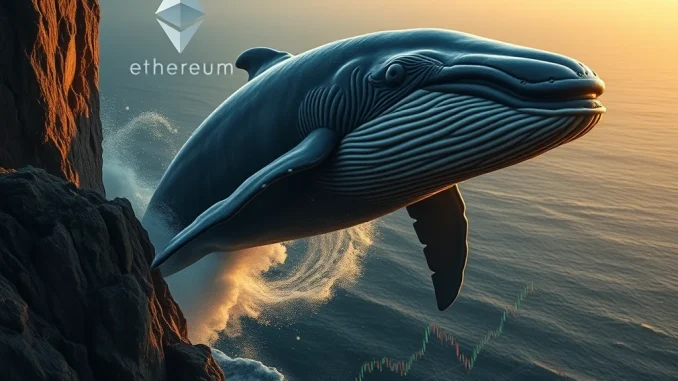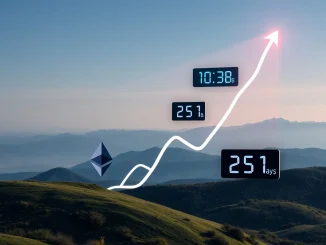
A tremor of unease is rippling through the Ethereum (ETH) market as a colossal whale, holding a staggering 64,792 ETH, teeters precariously on the edge of liquidation. On-chain analytics provider ai_9684xtpa flagged this critical situation on X, revealing that a mere $3 separates the current Ethereum price from triggering a massive liquidation event for this deep-pocketed investor. In a potentially calculated maneuver, the whale executed a significant USDT withdrawal of $1.68 million from the Bitfinex exchange just an hour ago. However, this substantial sum has yet to be injected as collateral into MakerDAO, leaving market participants on tenterhooks, wondering about the whale’s next strategic play amidst the swirling crypto market move.
Who is This Enigmatic ETH Whale and Why Does Their Liquidation Matter?
In the world of cryptocurrency, ‘whales’ are individuals or entities that hold substantial amounts of a particular digital asset. Their actions, especially those of an ETH whale, can significantly influence market dynamics due to the sheer volume of their holdings. A potential liquidation of such a large position isn’t just about one investor’s portfolio; it can trigger a cascade effect, exacerbating market volatility and potentially leading to further price drops. Imagine a domino effect – if this whale’s position is liquidated, it could force automated selling of their ETH, pushing the Ethereum price down further, which in turn could trigger liquidations for other leveraged positions. This is why the market is watching this situation with bated breath.
Decoding the Looming Threat: Understanding ETH Liquidation Threshold
The term ‘liquidation threshold’ is crucial in understanding the gravity of this situation. In decentralized finance (DeFi) platforms like MakerDAO, users can borrow cryptocurrency by providing collateral, often in the form of ETH. The liquidation threshold is a critical price level for the collateral asset. If the price of ETH, in this case, drops to or below this threshold, the DeFi protocol automatically sells off the collateral to repay the loan and protect the platform from losses.
Here’s a simplified breakdown:
- Collateral: The ETH held by the whale in MakerDAO acts as security for a loan (likely in DAI, a stablecoin pegged to the US dollar).
- Loan-to-Value Ratio (LTV): MakerDAO, like other DeFi platforms, operates with LTV ratios. This ratio determines how much can be borrowed against the collateral.
- Price Fluctuation Risk: If the value of ETH (the collateral) decreases, the LTV ratio increases.
- Liquidation Trigger: When the LTV ratio hits a predetermined critical point (the liquidation threshold), the protocol initiates liquidation.
With only a $3 buffer remaining, this ETH whale liquidation event is not just a possibility; it’s a very real and imminent danger. The small margin highlights the precariousness of leveraged positions in the volatile crypto market.
The $1.68M USDT Withdrawal: A Calculated Move or a Sign of Panic?
The whale’s USDT withdrawal of $1.68 million from Bitfinex adds another layer of intrigue to this unfolding drama. USDT (Tether) is a stablecoin, designed to maintain a 1:1 value with the US dollar. Withdrawing such a significant amount of USDT could indicate several potential strategies:
- Awaiting Market Dip to Buy More ETH? The whale might be anticipating a further dip in the Ethereum price, intending to use the withdrawn USDT to buy more ETH at a lower price, thus increasing their ETH holdings and potentially lowering their average entry price.
- Preparing to Add Collateral (Eventually)? While the USDT hasn’t been added to MakerDAO yet, it’s possible the whale is waiting for the opportune moment. They might be monitoring market movements closely, planning to inject the USDT as collateral if ETH price stabilizes or shows signs of recovery.
- Risk Mitigation and Diversification? In a more defensive move, the whale could be withdrawing USDT to reduce their exposure to ETH and potentially diversify into other assets, hedging against further ETH price declines and the risk of liquidation.
- Simply Repositioning Funds? It’s also possible that this USDT withdrawal is part of a larger portfolio rebalancing strategy, unrelated to the immediate liquidation threat, though the timing is certainly noteworthy.
The fact that the USDT hasn’t been immediately deployed as collateral suggests a degree of caution and strategic thinking, rather than outright panic.
MakerDAO’s Role: The DeFi Protocol Under Scrutiny
MakerDAO, the decentralized autonomous organization behind DAI, is at the center of this potential liquidation event. As a leading DeFi lending platform, MakerDAO allows users to generate DAI by locking up collateral like ETH. The protocol’s robust liquidation mechanism is designed to ensure its solvency and the stability of DAI.
Here’s why MakerDAO is relevant in this context:
- Decentralized Lending: MakerDAO facilitates decentralized lending and borrowing, removing intermediaries.
- DAI Stability: The liquidation mechanism is crucial for maintaining DAI’s peg to the US dollar.
- Transparency: All transactions and protocol rules are transparent and auditable on the blockchain.
- Systemic Risk: Large liquidations on MakerDAO can impact the broader DeFi ecosystem and ETH market dynamics.
The market is keenly observing how MakerDAO’s liquidation mechanism will perform if triggered, and the potential implications for the platform and the wider DeFi space.
Awaiting the Market Move: What’s Next for the Whale and the ETH Price?
The crypto community is now holding its breath, anticipating the whale’s next move and the overall crypto market move. Several scenarios could unfold:
- ETH Price Recovery: If the Ethereum price rebounds, even slightly, it could provide the whale with the breathing room needed to avoid liquidation. Positive market sentiment or broader crypto market recovery could trigger this.
- Collateral Injection: The whale might strategically add the $1.68 million USDT (or potentially other assets) as collateral to their MakerDAO vault, increasing their collateralization ratio and moving further away from the liquidation threshold.
- Partial Liquidation: If the ETH price continues to decline and the whale doesn’t act, a partial liquidation could occur, where a portion of their ETH is sold off to bring their position back to a safe collateralization level.
- Full Liquidation: In a worst-case scenario, if the Ethereum price plummets further and breaches the liquidation threshold significantly, a full liquidation of the whale’s 64,792 ETH position could be triggered.
The next few hours and days will be critical in determining the outcome. Market participants are closely monitoring on-chain data, Ethereum price charts, and any further actions from the whale’s wallet.
Conclusion: Navigating the Volatile Crypto Seas – Lessons from the Whale Watch
This unfolding situation with the ETH whale liquidation threat serves as a stark reminder of the inherent volatility and risks within the cryptocurrency market. It highlights the delicate balance between risk and reward in leveraged trading and the potential for significant market movements driven by large players. Whether this whale manages to navigate these treacherous waters or succumbs to the liquidation event, the market will undoubtedly learn valuable lessons. For now, all eyes remain glued to the charts, waiting to see how this high-stakes drama plays out in the ever-turbulent crypto seas. Stay tuned for further updates as this developing story unfolds.



